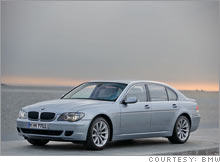|
BMW steps on (the hydrogen) gas Next month BMW will unveil the first production-ready hydrogen car. Here's why this luxury sedan is headed in the right direction.
(Business 2.0 Magazine) -- It would be so easy to disparage the BMW Hydrogen 7, the world's first production-ready hydrogen car and a guaranteed showstopper when it's unveiled next month at the Los Angeles Motor Show. After all, BMW plans to build only 100 of these vehicles next year. Of those, a mere 25 are headed to the U.S. Even then, only "ideal ambassadors" will be allowed to drive them, a BMW spokesman told CNNMoney last month. And those lucky few might have to pay a monthly fee for the privilege.
In other words, if you live in an area without hydrogen fueling stations - which, by the way, happens to be most of America - you're out of luck. But let's look beyond these shortcomings. What's important about the Hydrogen 7 isn't how fast it's being rolled out or who gets to drive it. It's what's under the hood that matters. The problem with fuel-cell cars Think of this car as a hydro-hybrid: It has two separate fuel tanks - one for hydrogen and the other for regular gasoline. The Hydrogen 7 can switch between the two at the press of a button. This means you can help the planet and America's energy independence whenever you're near a hydrogen fueling station, and fill 'er up at the gas pump the rest of the time. This is a brilliant move by BMW (Charts). Hydrogen may well be the fuel to bet on in the long term. It is the most abundant and, all other factors being equal, the cheapest. Gas, ethanol, coal and organic waste can all be converted into hydrogen. Water can be separated into hydrogen and oxygen, if you have enough cheap electricity to do it (and experts say we can get that cheap electricity from geothermal plants). Until recently, however, BMW shied away from the hydro-hybrid approach, spending its energies on the idea of making a hydrogen fuel-cell car instead. We've been hearing about this pie-in-the-sky prototype for a decade now. Indeed, every automaker seems to have fuel-cell concept vehicle to show off, like the F-Cell from DaimlerChrysler (Charts), the Chevrolet Sequel, the Ford Focus FCV, and the Volkswagen Touran Hy-Motion. In a bid to steal BMW's thunder, General Motors (Charts) trumpeted, two days after the Hydrogen 7 was announced, its own plans to unveil a line of fuel-cell vehicles - the Hy-Wire and the HydroGen3 - by 2011. Here's the big problem with fuel-cell cars: They're all or nothing. You need a massive infrastructure of hydrogen-fueling stations for drivers to happily tool along with a clean conscience. If that support isn't there, they can't. A coming feast of fuel options But the hybrid concept is - pardon the pun - fully road-tested. The Toyota Prius gas-electric hybrid has enormous buzz, not to mention lengthy waiting lines at the local dealership. Consumers who agonize over this country's oil-dependence feel happier driving a Prius, even if it burns gas at speeds over seven mph. (Disclaimer: I bought a Prius, the first generation model, in 2002, back when hybrid cars were an unusual concept and free of waiting lines.) The Prius, and its hybrid counterparts from Honda (Charts), were just the beginning. We noted in the September issue of Business 2.0 that Brazil has tribrids - cars that run on gas, electricity and sugar-cane ethanol. Rio de Janeiro-based Obvio will export tribrids to the U.S. in mid-2007. Mazda (Charts), meanwhile, is road-testing its RX-8 sports car, which, like the Hydrogen 7, uses hydrogen and gas fuel tanks. And at the 2006 Detroit Auto Show in January, Ford (Charts) gave us a sneak peek at its F-250 Super Chief, a truck that runs on gasoline, ethanol or hydrogen. It's the old rule of the marketplace: consumers are happiest when they have a choice. And with the growth of hybrid technology, you can envision the day when your family car has as many fueling options as your family itself. While your kids run inside the gas station to load up on Mountain Dew and Nesquik, you stand at the pump and order a special brew of corn ethanol, switchgrass ethanol, diesel, hydrogen for the hydro tank, and an old-school, highly-taxed, strange-smelling substance called gasoline. Rolling, not racing, to the future Globally, there already is a hydrogen infrastructure that produces 50 million tons of the stuff every year - enough to power 200 million hydrogen cars - most of it coming from natural gas. Of course, a future full of hydrogen cars is going to take time and money to create. But it won't take as many greenbacks as you might think. According to a GM study, $400 million would seed the greater Los Angeles area with 400 hydro stations, or one every two miles. The more cars there are like the Hydrogen 7, the more infrastructure will slowly appear to support them. "Slowly" is the operative word here. Consumers don't really care what goes in their cars as long as it's cheap. So the shift from gas, to the interim stage of multiple-choice fuels, to the long-term hydrogen economy, may go unnoticed by the public. This is the way the world is saved: not with a bang, but with a shrug. |
|

